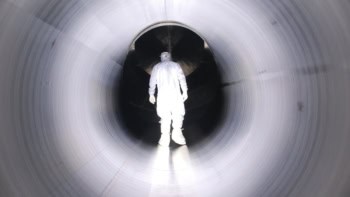
Two independent groups of theorists have predicted the existence of a stable “tetraquark” containing two heavy (bottom) quarks and two light antiquarks. They say that the particle could be detected in a few years’ time at the LHCb experiment on the Large Hadron Collider at CERN.
Quarks were proposed by Murray Gell-Mann and George Zweig in 1964 as the fundamental building blocks of protons, neutrons and other baryons, which contain three quarks, and mesons, made up of a quark and an antiquark. Since then physicists have also studied the possibility of more exotic composites, including tetraquarks, composed of two quarks and two antiquarks, and pentaquarks, which comprise four quarks and an antiquark.
A number of particles resembling tetraquarks have been observed at colliders over the past decade or so, such as the X(3872) particle first detected by the Belle experiment in Japan in 2003. More recently in 2016, the discovery of a tetraquark was claimed by physicists working at Fermilab. However, researchers working at LHCb were not able to confirm the Fermilab result.
Chris Quigg of Fermilab says that no definitive discovery has yet been made because it has never been entirely clear whether the detected particle debris – taken to be the components of tetraquarks – are created together or separately in the collisions. “In the case of tetraquarks, people can always put forward alternative explanations,” he says.
Heavy and light
Now, Quigg and his Fermilab colleague Estia Eichten on the one hand, and Marek Karliner of Tel Aviv University together with Jonathan Rosner of the University of Chicago on the other, say they have proved the existence of a tetraquark made from two of the heaviest quarks (bottom quarks) – and the two lightest antiquarks, an antiup and an antidown. The quark notation for the particle is bbu d.
Karliner and Rosner rely more heavily on experimental data in their analysis, particularly those from the discovery at LHCb in July of the Ξ++cc particle, which consists of two (heavy) charm quarks and an up quark. The pair had predicted back in 2014 that Ξ++cc should have a relatively low mass owing to the charm quarks attracting each other very strongly and thereby lowering their binding energy. In fact, the researchers reckoned that the charms’ binding energy ought to be half that of a charm-anticharm pair in mesons such as the J/psi particle.
Their reasoning was vindicated when the observed mass of Ξ++cc – 3621 +/-1 MeV/C2 – turned out to match the predicted value – 3627 +/-12 MeV/C2. In the latest work, they extrapolate their approach to a system containing two bottom quarks, rather than two charm quarks, and posit that the binding energy of the bb pair in bbu d is half that of a b b pair, which, they say, is well known from the masses of mesons such as the upsilon. By then incorporating the known mass of a u d, they work out that the tetraquark ought to weigh in at 10389 MeV/C2, give or take 12 MeV/C2.
Very stable
The researchers point out that this value is significantly lower – by some 215 MeV/C2 – than that of the lightest combination of known baryons and mesons with the correct properties. As such, they say, this tetraquark will be stable under the strong interaction, the force that holds protons and neutrons together. It will instead only decay via the weak interaction, for which typical decay times – a relative eternity at 10-13 s – are about ten orders of magnitude longer than that of the strong interaction. “This hadron is as stable as ordinary baryons and mesons that only decay through the weak interaction,” says Karliner.
Quigg and Eichten reach a similar conclusion but starting from first principles. They consider an idealised case in which two infinitely heavy quarks combine with two light antiquarks, and they find that the resulting particle should be stable and only decay via the weak interaction. Such a particle, says Quigg, can be thought of as a helium nucleus – the (very small) pair of quarks – with two electrons orbiting it.
To apply their finding to the real world, the pair then made “controlled approximations” in which they substituted the infinitely heavy quarks with ones having a large but finite mass. Relying (in the absence of the necessary experimental data) on Karliner and Rosner’s calculation of doubly heavy baryon masses, they calculated the properties of specific tetraquarks. They too conclude that those made from bb pairs should be stable, while others containing charm quarks should break down into pairs of mesons.
Reassuring conclusion
Karliner finds it “very reassuring” that the two studies reach essentially the same conclusion, even if, as he points out, “there is some difference in the specific numbers”. He is also optimistic that the bbu d particle can be discovered experimentally, estimating that this should occur about two to three years after LHCb has had its effective luminosity boosted by a factor of five – an upgrade expected to take place in 2021.
Tim Gershon of the University of Warwick, who is UK spokesperson for LHCb, is a little more cautious, arguing that “it will take some time” to understand the sensitivity of current experiments to bbu d. He says that the tetraquark’s weak decay will generate “a striking experimental signature” but that the signature will only emerge after vast numbers of collisions have been analysed. Nevertheless, he adds, “we can overcome very small probabilities with very large data samples”, noting that LHCb may get a second upgrade in the 2030s to make best use of the high-luminosity LHC. “I tend to think that the prospects are reasonably good in the long term,” he says.
The research is described in two papers in Physical Review Letters.



